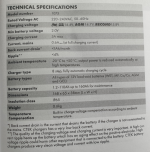Pudsey Bear
Full Member
- Messages
- 14,142
the only new thing is the Ctek which I put on on Christmas day, but surely that isn't adding 40p overnight, the vans charger is turned off so only the Ctek MXS5 is running.
But my maths seems to say 5a x 230v =1150w or £9.38p which is of course wrong, and trying to explain is painful as I don't know what it is using per 24 hours.
The manual seems to say nothing helpful and I have Liz telling me to turn it off.

But my maths seems to say 5a x 230v =1150w or £9.38p which is of course wrong, and trying to explain is painful as I don't know what it is using per 24 hours.
The manual seems to say nothing helpful and I have Liz telling me to turn it off.

